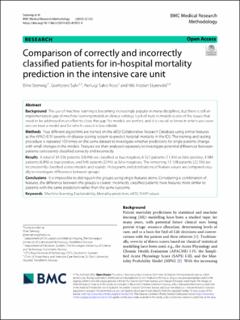| dc.contributor.author | Stenwig, Eline | |
| dc.contributor.author | Salvi, Giampiero | |
| dc.contributor.author | Salvo Rossi, Pierluigi | |
| dc.contributor.author | Skjaervold, Nils Kristian | |
| dc.date.accessioned | 2023-10-26T09:20:45Z | |
| dc.date.available | 2023-10-26T09:20:45Z | |
| dc.date.created | 2023-05-04T19:24:20Z | |
| dc.date.issued | 2023 | |
| dc.identifier.citation | BMC Medical Research Methodology. 2023, 23 (1), 102-?. | en_US |
| dc.identifier.issn | 1471-2288 | |
| dc.identifier.uri | https://hdl.handle.net/11250/3098884 | |
| dc.description.abstract | Background
The use of machine learning is becoming increasingly popular in many disciplines, but there is still an implementation gap of machine learning models in clinical settings. Lack of trust in models is one of the issues that need to be addressed in an effort to close this gap. No models are perfect, and it is crucial to know in which use cases we can trust a model and for which cases it is less reliable.
Methods
Four different algorithms are trained on the eICU Collaborative Research Database using similar features as the APACHE IV severity-of-disease scoring system to predict hospital mortality in the ICU. The training and testing procedure is repeated 100 times on the same dataset to investigate whether predictions for single patients change with small changes in the models. Features are then analysed separately to investigate potential differences between patients consistently classified correctly and incorrectly.
Results
A total of 34 056 patients (58.4%) are classified as true negative, 6 527 patients (11.3%) as false positive, 3 984 patients (6.8%) as true positive, and 546 patients (0.9%) as false negatives. The remaining 13 108 patients (22.5%) are inconsistently classified across models and rounds. Histograms and distributions of feature values are compared visually to investigate differences between groups.
Conclusions
It is impossible to distinguish the groups using single features alone. Considering a combination of features, the difference between the groups is clearer. Incorrectly classified patients have features more similar to patients with the same prediction rather than the same outcome. | en_US |
| dc.language.iso | eng | en_US |
| dc.publisher | BMC | en_US |
| dc.rights | Navngivelse 4.0 Internasjonal | * |
| dc.rights.uri | http://creativecommons.org/licenses/by/4.0/deed.no | * |
| dc.title | Comparison of correctly and incorrectly classified patients for in-hospital mortality prediction in the intensive care unit | en_US |
| dc.title.alternative | Comparison of correctly and incorrectly classified patients for in-hospital mortality prediction in the intensive care unit | en_US |
| dc.type | Peer reviewed | en_US |
| dc.type | Journal article | en_US |
| dc.description.version | publishedVersion | en_US |
| dc.source.pagenumber | 102-? | en_US |
| dc.source.volume | 23 | en_US |
| dc.source.journal | BMC Medical Research Methodology | en_US |
| dc.source.issue | 1 | en_US |
| dc.identifier.doi | 10.1186/s12874-023-01921-9 | |
| dc.identifier.cristin | 2145665 | |
| cristin.ispublished | true | |
| cristin.fulltext | original | |
| cristin.qualitycode | 1 | |

